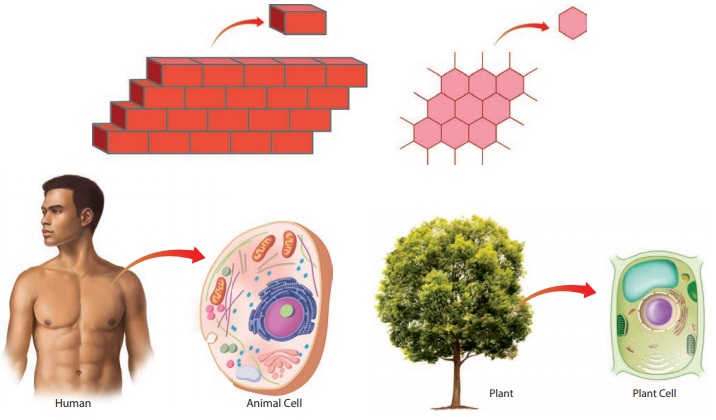Cell Biology | Term 2 Unit 4 | 7th Science - Cell as a fundamental unit of life | 7th Science : Term 2 Unit 4 : Cell Biology
Chapter: 7th Science : Term 2 Unit 4 : Cell Biology
Cell as a fundamental unit of life
Cell as a
fundamental unit of life:
The building wall is made up of numerous bricks.
In the similar manner, a bee hive is composed of numerous hexagonal units. Some
of the organisms are represented by a single cell. Therefore, they show a
simple organization. The basic functional unit of an organism is called, a
cell. Structure of a cell represent the arrangement of parts or organells in a
cell.

Function is the activity of each part or organell
in a cell. Cells are the basic building blocks of an organism. You learnt that
atoms are the basic building blocks of matter in chapter three. Likewise, human
body is made up of animal cell and plant is made up of plant cell.
Unicellular
organisms
Some simple organisms, are made up of only one
cell. They are called unicellular organisms, which can be seen with the help of
a microscope. There are many single – celled microscopic organisms.
Have a look at the image. Chlamydomonas and
an Amoeba, a single cell organisms which carryout entire
functions. The body of all organisms are made up of tiny building blocks
called, cells. Bacteria are also one celled unicellular organisms.

Multicellular
Organism
The cells are organized into tissues, organs and
organ systems in a multicellular organism. Macroscopic organisms are visible and consists of many
cells. The body of macroscopic organisms involves various functions. You can
see cells of onion and human through a microscope. Onion and man are examples
for multicellular organism.

Cell to
organism
Many cells function together to form tissues,
different tissues combined together to form an organ and different organs to
form an organ system, which leads to form an organism.
Organisms
Many types of organ systems function together in a
body, e.g. respiratory system, digestive system, excretory system circulatory
system etc.
Organ System
Many organs together form an organ system, which
is concerned with a specific function. For example, Respiratory system, which
has organs like nostrils, nasal chamber, wind pipe and lungs that helps in the
process of respiration. In a plant, the root system consists of primary root,
secondary root and tertiary root, which does the function of conduction of water,
mineral and also fixation.

Organ
A collection of different tissues worked together
to perform a specific function or functions is called an organ. Human body has
different organs like stomach, eye, heart, lungs etc., are made up of different
type of tissues. Plant have organs such as leaves, stems, and roots.
Tissue
Tissue is a group of cells, organized for a
specific function. Tissues have following features like same shaped cells or
different shaped cells to perform a common function. Human and other animals
are made up of nervous, epithelial, connective and muscle tissues. Plants have
transport, protective and ground tissues.
Cell
The cell is a basic structural and functional unit
of life. Cell is the building unit of living organisms. You can see in a hand,
how many types of cells are there to work together to perform its functions.
So, cell is known as the basic unit of life.

ACTIVITY 2
Find out major organs that are part
of the circulatory system of a human body and listout their functions
Heart - It pumps out blood.
Auricles - Upper chambers of
the heart
Ventricles - Lower chambers of the
heart
Arteries - They carry oxygenated blood to different
parts of the body.
Veins - They carry
oxygen-poor blood back from the body to the heart
Capillaries - They bring nutrients
and oxygen to the tissues and remove waste products from the tissues.
Lungs - The alveoli in lungs purify the blood by
supplying oxygen and removing CO2 from blood.
Related Topics